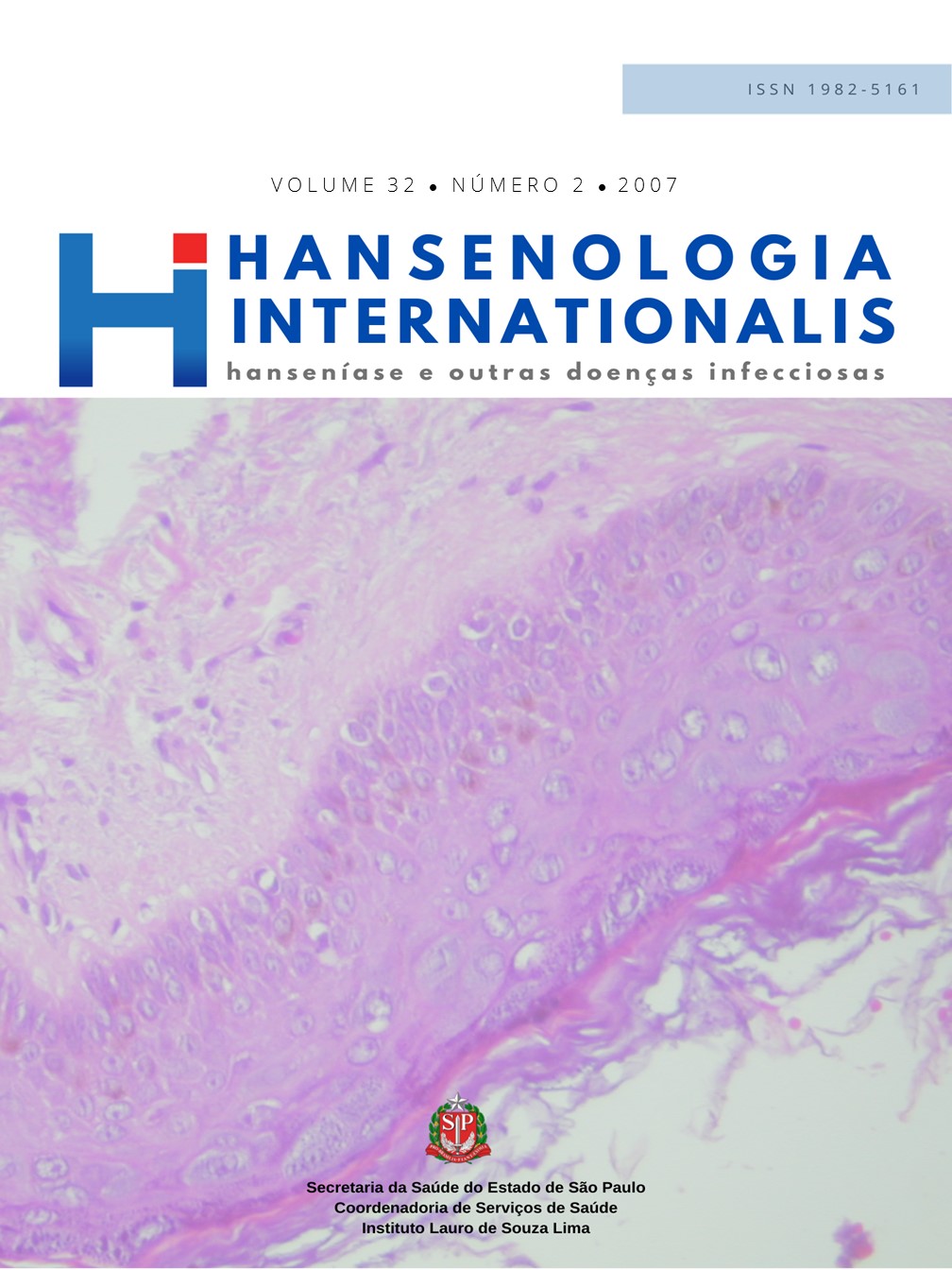Abstract
Leprosy reaction is one of the greatest problems in leprosy control programs. During treatment or even after end of treatment, many patients return to the healthcare unit with reactions characterized by inflammatory process, pain, malaise and at times a increased grade of incapacity. The inability to estimate the magnitude of leprosy reaction in the Rio de Janeiro municipality difficulted the planning of effective leprosy control program. This study demosntrated the frequency of reactions in patients from the basic health units who were treatedwith multidrugtherapy (MDT) from 1991 to 2004. The study also characterized the socio-demographic and clinical profile associated to the occurrence of reactional episodes in patients of the study. This is a cohort non-concurrent study using as data source 667 medical charts. The majority of leprosy patients were between 35 and 54 year, they were mostly married womem (52.3%) with low schooling levels. During the evaluation period 43.5% patients presented reactions. The reaction rate was higher among: males (49.4%, n=157, patients with borderline or lepromatous forms, positive bacillary index, grade of incapacity zero and one and patients who received over 12 doses of treatment. These characteristics should be taken into account when caring for leprosy patients, so that early detection of reactions and initiation of specific treatment may diminish the onset of physical incapacities and sequels.
References
2. Andrade M. A cura como conceito vivido: o ex-sistir das 2 pessoas que se submeteram a poliquimioterapia para tratamento da hanseníase [tese de doutorado]. Rio de Janeiro: Escola de Enfermagem Anna Nery da Universidade Federal do Rio de Janeiro; 1997.
3. Foss NT, Goulart IMB, Gonçalves HS,Virmond M. Han3 seníase: Episódios Reacionais. Simpósio: Urgências e Emergências Dermatológicas e Toxicológicas. SociedadeBrasileira de Hansenologia e Sociedade Brasileira de Dermatologia. Disponível em: http://www.fmrp.usp.br/revista/2003/36n2e4/37episodios_reacionais_hanseniase.pdf.
4. Ministério da Saúde (BR). Secretaria de Políticas. Departamento de Atenção Básica. Guia para o Controle da Hanseníase. (Série Cadernos de Atenção Básica, 10). Brasília: Ministério da Saúde; 2002.
5. Nery JAC. Reação na Hanseníase: uma descrição epidemiológica. [dissertação de mestrado]. Niterói: Universidade Federal Fluminense; 1995.
6. Oliveira CR, Alencar MJF, Santana SC, Nascimento GF, Neto SAS. Estudo dos fatores que influenciaram a inadequação do diagnóstico e acompanhamento dos estados reacionais nos pacientes com hanseníase no estado de Rondônia. In: Mostra Nacional de Experiências Bem-Sucedidas em Epidemiologia, Prevenção e Controle de Doenças, 3; 2004; Brasília; Brasil.
7. Pimentel MIF. Neurites na Hanseníase: significado de parâmetros clínicos e epidemiológicos na indução e agravamento das incapacidades físicas em pacientes multibacilares [dissertação de mestrado]. Rio de Janeiro: Faculdade de Medicina da Universidade Federal do Rio de Janeiro; 1998.
8. Coeli CM, Faerstein E. Estudos de Coorte. In: Medonho et al. Epidemiologia. São Paulo: Atheneu; 2002. p. 161-73.
9. Gallo Men, Nery JAC, Albuquerque ECA, Sigmorelli M, Filho VFS. Hanseníase multibacilar: índices baciloscópicos e viabilidade do M. leprae após 24doses da PQT/OMS. In: Anais brasileiros de Dermatologia; 2000; Rio de Janeiro, Brasil. Rio de Janeiro: Associação Brasileira de Dermatologia.
10. Miranda MBS. Reações Hansênicas: estudo comparativo com esquemas poliquimioterápicos no Distrito Federal [dissertação de mestrado]. Brasília: Universidade de Brasília; 2005.
11. Ustianowski AP, Lockwood DNJ. Leprosy current diagnostic and treatment approaches. Curr. Opin. Infect. Dis. oct.2003; 16(5): 421-7.
12. Lochwood DNJ, Vinayakumar S, Stanley JNA, McAdam KPWJ, Colston MJ. Clinical features and outcome of reversal (Type 1) reactions in Hyderabad. International Journal of Leprosy 1992; 61(1): 8–15.
13. Saunderson P, Gebre S, Byass P. Enl reactions and impairments in the multibacillary cases of the AMFES cohort in central Ethiopia: incidence and risk factors. Leprosy Review 2000; (71): 318-24.
14. Manandhar R, Lemaster JW, Roche P. Risk factors for erythe ma nodosum leprosum. International Journal of Leprosy 1999; (67): 270-8.
15. Lienhardt C, Fine PEM. Type 1 reaction, neurits and disability in leprosy. What is the current epidemiological situation? Leprosy Review 1994; (65): 9-33.
16. Talhari S, Neves RG, Penna GO, Oliveira MLW. Hanseníase – Dermatologia Tropical. 4 ed. Manaus; 2006.
17. Gillis TP, Krahehbuhl JL. Global elimination of leprosy. Reviews in Medical Microbiology 1998; (9): 39-48.
18. Rijk AJ, Gabre S, Byass P, Berhanut T. Field evaluation of WHO-MDT of fixed duration at ALERT, Ethiopia. The AMFES project – II. Reaction and neurits during and after MDT in PB and MB leprosy patients. Leprosy Review 1994; (65): 320-32.

This work is licensed under a Creative Commons Attribution 4.0 International License.
